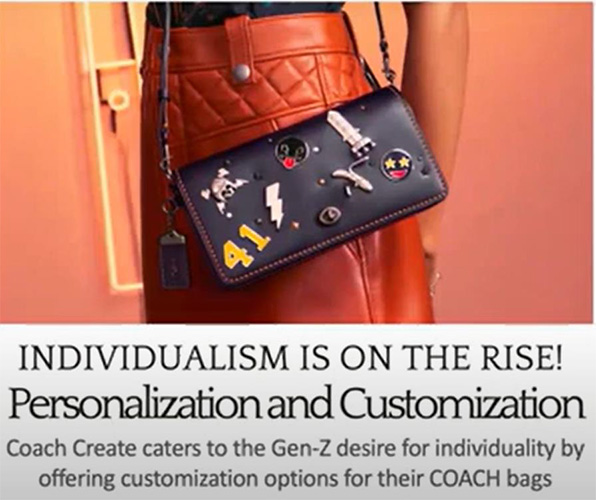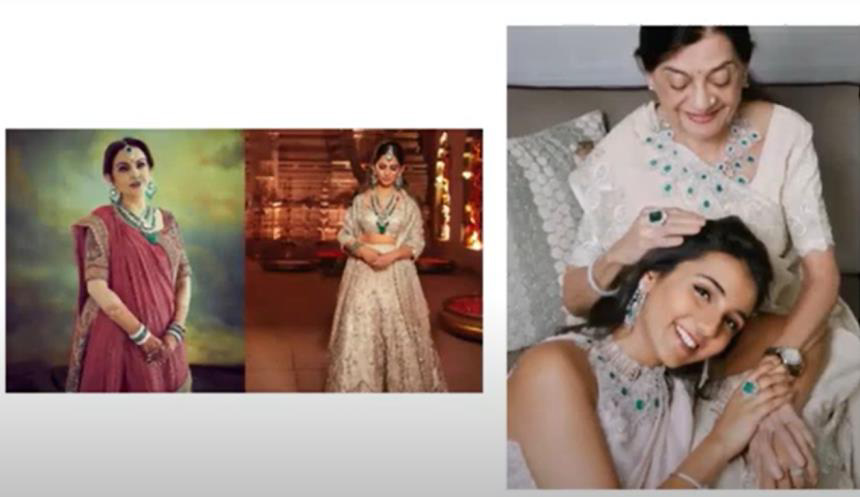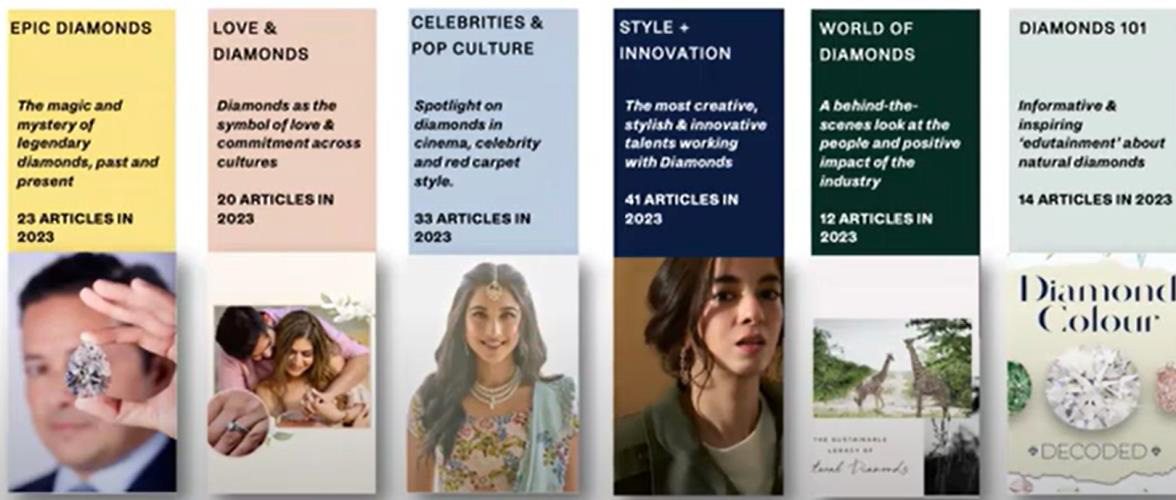An evening with Ms Richa Singh
On Friday, August 2, we had an engaging session by Ms Richa Singh, who has been Managing Director of the Natural Diamond Council for India and the Middle East since October 2017. Ms Singh has transformed the Natural Diamond Council into the ultimate destination for natural diamonds. Ms Singh spoke about: "Natural Diamonds: A Symbol of Conscious Luxury
About Ms Richa Singh
Ms Singh completed her MBA (1996-98) from the prestigious SP Jain Institute of Management & Research (SPJIMR). Her professional journey began as a Senior Account Executive at JWT (1998 to 2002). She then embarked on a 14-year tenure at L'Oréal, where she held several key positions, including General Manager of L'Oréal Luxury (September 2013 to April 2016), General Manager of Matrix (August 2011 to August 2013), and Marketing Manager ( May 2002 to July 2011).
Since 2017, Ms Richa Singh has been the Manging Director of the Natural Diamond Council (NDC). Under her leadership, NDC has emerged as the world's premier publishing destination for natural diamonds. She has pioneered an innovative and successful digital-forward strategy, to some extent triggered by the challenging times of the pandemic. She has championed sustainability and conscious luxury.
Ms Singh’s vision and dedication have been instrumental in highlighting the sustainability efforts within the diamond industry. These efforts are resonating with the desires and preferences of younger consumers.
Ms Singh has introduced new ways of discussing conscious luxury, making natural diamonds synonymous with slow fashion. Good examples are collaborations with Vogue for the first-of-its-kind virtual Diamond Festival and partnerships with designers at Lakme Fashion Week.
In 2022, Ms Singh spearheaded NDC’s expansion into the UAE market, launching the brand in partnership with leading retailers such as Jawhara Jewellery, Malabar Gold & Diamonds, and La Marquise Jewellery. Additionally, she has led the publication of the second edition of the diamond jewellery trend report.
Ms Singh’s exceptional contributions have earned her the country’s first Gold Cannes Lion in media. She has also been recognized as one of Luxebook’s Top 50 India’s Most Powerful Women in Luxury in 2021. With her successful track record in India, she is now focused on enhancing NDC’s reach and influence in the UAE.
Natural diamonds as a category
In her career as a marketing professional, Ms Singh has spent time in mass market products, B2B products and now she is in the luxury segment. Diamonds is the largest luxury category, but it does percolate like mass products.
Competition for natural diamonds comes not from just other forms of jewellery but also from travel, automobiles, food and beverages. Ms Singh feels that anything which can distract customers is a competitor to natural diamonds.
The new age consumer
The new age consumer is embracing conscious luxury. Conscious luxury refers to luxury products that are produced in a sustainable and ethical manner. The materials used are sourced responsibly, the production processes are environmentally friendly, and the workers involved are treated fairly.
There is a higher level of awareness today among consumers. There are also opportunities to try out things much earlier. The earlier generation of customers had the desire but not the opportunities that today’s customers enjoy.
The luxury consumers are discerning and expect much more from the brand because of greater exposure. They want to be one step ahead of other customers. They want purchases to be more experiential, be it online, in the store or as part of their travel experiences.
Individualism is on the rise. Personalization and customization are key and expected. Customers want to feel special. Today, customization is possible not just at the time of purchase but even later. Coach is a good example.

Today’s consumers are also characterised by nano attention. Within a day, there are various opportunities for brand exposure. So, getting and retaining their attention is a major challenge. Marketers only have seconds to get their message across.
Sustainability
Today’s consumer is challenging traditional notions of luxury and value. So it is important to keep reassuring consumers that the brand stands for goodness. In this context, sustainability is no longer a buzzword today. It is more of a hygiene factor. It is becoming an integral part of the brand.
The customer may not be actively thinking of climate change or water conservation or biodiversity at the time of purchase. But the customer does feel good when she realizes that the brand is doing good things for society.
The diamond industry is moving towards sustainability very proactively and sharing updates with customers. The industry is working towards a greener future be it tree plantation or water conservation or use of renewable energy. The industry has realized that the diamond brand must be much more than a commercial proposition.
The industry is way ahead of the curve when it comes to meeting UN SDG. Some initiatives such as recycling of water and use of renewable energy are logical and conventional. But the industry has also been proactive and launched initiatives such as 100 lakes, anticipating what will be good for society in the long run, say 20 years from now. These investments have nothing to do with business and are more about giving back to society.
Note: The Hari Krishna Group, a leading construction company based in Surat takes social responsibility seriously. Apart from tree plantation initiatives, the Group has undertaken various other initiatives to contribute towards a sustainable environment. One such initiative is the creation of 100+ manmade lakes in Gujarat under the project name “Hari Krishna Sarovar”. This project when launched, set the target of creating 100+ lakes by 2025. But by 2022, this target was crossed with 111 lakes established. The lakes will not only enhance the local ecosystem but also provide a source of water to nearby communities. The project has received recognition from the UN.
Slow fashion
Natural diamonds are synonymous with slow fashion. Jewellery can be reused again and again. It is never thrown away. There is no wastage. This is unlike most other products. (Even luxury cars and Kanchivaram sarees which have vintage value do not stay the same over time.) Children typically wear jewellery worn by their mother or grandmother. See figure below.

The 30 wear challenge is about wearing a product 30 times. Jewellery is the clear winner. It can be worn 30 times in 30 days. Mangal Sutra and engagement rings can be worn again and again and enjoyed.
Emotional attachment
There is an emotion attached to diamonds which lasts forever. During Covid, women took out their jewellery from the lockers and felt an emotional connect after wearing it. They felt nostalgic and closer to their family members, (even though they were physically separated) when they were wearing jewellery given by their parents or grandparents.
Know it all/Have it all
Todays’ customers know it all and want it all. They do not want to compromise or make trade-offs. They want all the traditions and not give up on any of them. Indeed, customers take this as an entitlement. For example, Indians balance history with modernity. During Deepavali, they do Puja with great devotion and then gamble with Teen Pathi. They may wear an expensive piece of apparel at one time of the day and a simple one at another time.
Beyond entertainment
Now diamonds are going beyond the world of entertainment and the red carpet/couch. There is history and mystique associated with diamonds. We must remember that diamonds started with Gods, the moved to the royalty, followed by men and then only women. The NDC has curated content around these themes.

Todays’ sports stars and cinema stars and other celebrities are the modern maharajahs. What they say about the brand matters a lot. Ms Singh showed a video clip involving actor Ranbir Singh in this regard.
Content marketing
Along with the visuals such as red carpet, Ms Singh has focused on providing bits of information on various channels including WhatsApp/ Instagram. The material is bite sized, often proactive and sometimes in response to customer need. The aim is to educate customers about the products and the industry and the sustainability initiatives.
Digital
Digital plays a key role in customization. Natural diamonds have taken customization to another level. It helps that the jewellers know their customers well. Many customers spend a lot of time at jewellery shops and consider the jeweller to be their best friend and an extension of the family. The quality of engagement/experience enjoyed in the stores is now being replicated and improved digitally.
Here are some metrics to show how the digital strategy is gaining traction.- 65 million website hits
- 152 million social engagements
- 93 mn YouTube views
- 831 mn PR reach
- 1100 brand collaborations
The whole idea is to drive positive conversations among customers, improve consumer confidence and desire and make consumers fall in love with diamonds.
Q&A
Ms Singh’s father was in the defence services. From a young age, she was made to understand the importance of being self-reliant. One thing which Ms Singh learnt quickly in her career is that women need to ask. Then only they will get what they want. Often, there is no precedent. A woman should not hesitate to ask. Usually, the answer is yes. Sometimes the answer is no. In that case it provides an opportunity to find a way to make people say yes.
Ms Singh has never hesitated to ask for help. She has realized that it takes a village to juggle work and family responsibilities. Family members, team members, bosses have all played a role in Ms Singh’s career progression.
Ms Singh also emphasised the importance of upskilling and reskilling. This became particularly important during Covid. Many take reskilling for granted but it takes effort and commitment.
Women continue to face challenges in the workplace. They need support but they should also take the initiative. Ms Singh believes that calibre is more important than quotas. Ms Singh’s own team consists entirely of women, though she did admit that it is more of a coincidence than by design.
There has been a fall in diamond exports recently. However, this is only a temporary phenomenon. Production might fall sometimes but that is because there is only a finite quantity of diamonds. The long-term outlook for diamonds is bright. Akshaya Trithi saw good demand.
Diamonds protect value. They make us feel good and help us to express ourselves. The quality of Indian products- design and craftsmanship is exemplary. The desire for diamonds and curiosity among consumers is quite high.
People in the industry support each other and are open to sharing their knowledge. There are about 600,000 jewellers in the country. The AV Birla group announced a big investment of Rs 5000 cores recently.
The industry has high entry barriers as the cost of raw materials and finished products is quite high. Budding entrepreneurs should check and test the waters before raising funds. There is potential across various areas of the value chain.
Asia has a growing middle class. Ms Singh spoke at length about India and the Middle East. The Indian customer is aspiring. Every generation wants the next generation to lead a better quality of life. The middle class aspires to enjoy the good things of life. Diamonds fit in very well in this context. They hold value and create an emotional connect. They are often gifts passed on from one generation to the next and are always remembered with nostalgia. This kind of sentiment is common across Asia. However, taste and design might vary across countries. For example, Indians prefer 22 carat but the Middle East prefers 21 carat jewellery.
Natural coloured diamonds are still niche products, and their prices are way too high. There is some traction in yellow and a little in pink. But in general, coloured diamonds are not the entry point for customers.
Fancy cuts are becoming more popular: ovals, tear drops, trapezoids, etc.
Men do experiment when it comes to jewellery. They go for enamel. But they are not heavily into fancy cuts.
There was a time when diamonds were used to finance civil wars in Africa. But now with the Kimberley process followed in more than 60 countries, about 99.8% of diamonds are traceable. We can track from which mine the diamonds have come, where they have been cut and processed and who have been the artisans involved. So today, diamonds are largely conflict free.
Note: The Kimberley Process (KP) is a multilateral trade regime established in 2003. It aims at removing conflict diamonds from the global supply chain. Conflict diamonds are defined as: ‘rough diamonds used to finance wars against governments’. Today, participants actively prevent 99.8% of the worldwide trade. Under the Kimberley Process, countries implement safeguards on shipments of rough diamonds and certify them as “conflict free."
Under the Kimberley Process, the participants must:
- Satisfy ‘minimum requirements’ and establish national legislation, institutions and import/export controls.
- Commit to transparent practices and to the exchange of critical statistical data
- Trade only with fellow members who also satisfy the fundamentals of the agreement
- Certify shipments as conflict-free and provide the supporting certification
Participating members, civil society observers and the wider industry meet twice yearly and conduct monthly teleconferences. Adherence and implementation are monitored through ‘review visits’, regular exchange of data, statistical analysis and the annual reports.
Mines have been developed in many African countries and more recently in Canada.
When it comes to cutting and polishing, Surat is the unchallenged leader. The cluster has been able to grow talent and sustain a high quality of design and craftsmanship. Innovations are very common. New shapes and designs emerge regularly. The Surat cluster remains vibrant as the next generation keeps coming back to join the family business even though they are well educated and have other opportunities to pursue. About 90% of the world’s diamonds are cut and polished in India. Diamonds account for 5% of India’s merchandise exports. These diamonds are exported all over the world.
Antwerp and more recently Dubai have emerged as important trading hubs.
The US is the biggest consumer of diamonds.
